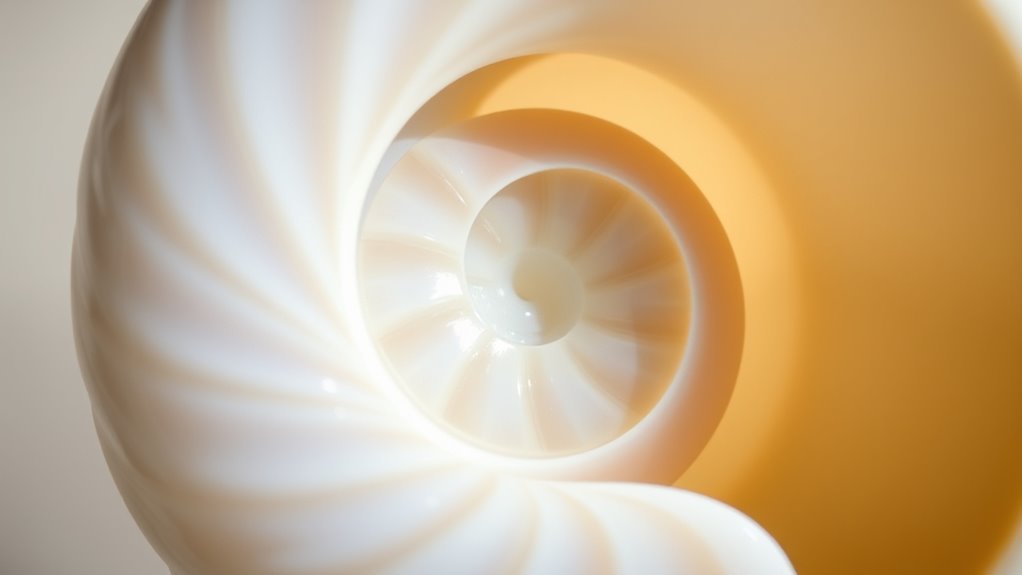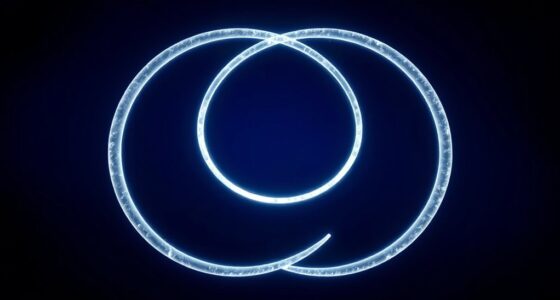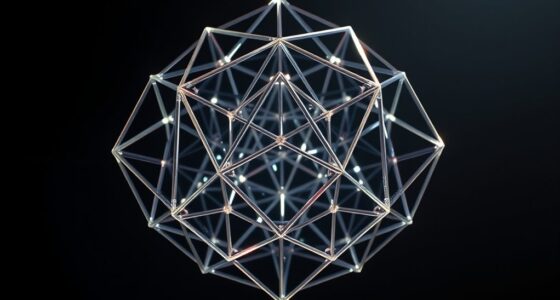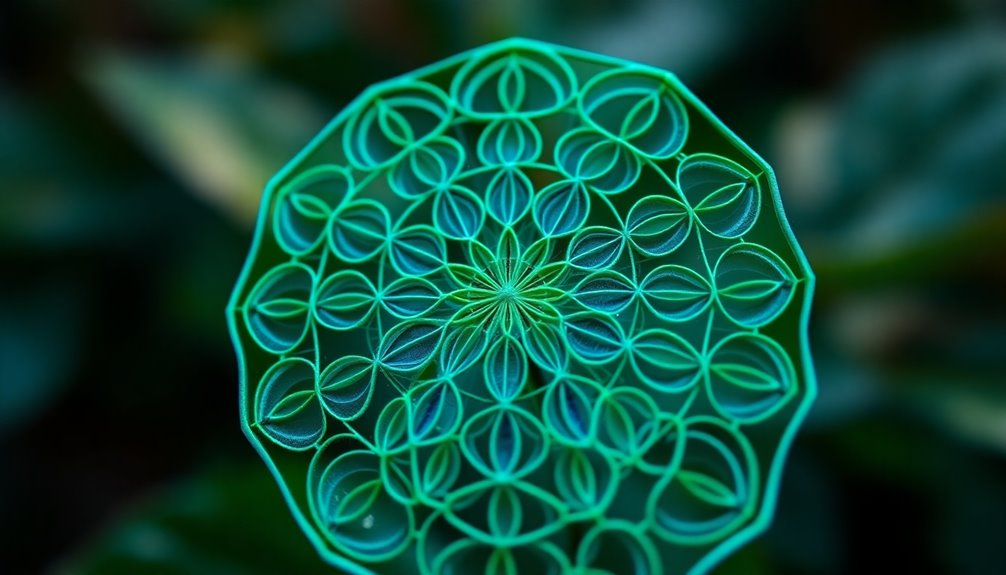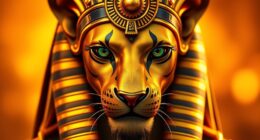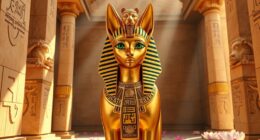The golden spiral and nautilus shell show how nature uses mathematical proportions to create harmony and growth. The spiral relies on the golden ratio, about 1.618, allowing the shell to expand while keeping its shape. This pattern appears in many natural forms, reflecting efficiency and beauty. Recognizing these patterns reveals how nature combines mathematics and design seamlessly. If you want to explore more about how these patterns shape our world, you’ll find plenty of fascinating insights ahead.
Key Takeaways
- The golden spiral is a natural pattern based on the golden ratio, creating an aesthetically pleasing curve seen in the nautilus shell.
- Nautilus shells grow by adding chambers proportionally, maintaining their shape through the golden ratio during expansion.
- The spiral’s mathematical foundation ensures that the shell’s structure remains balanced and efficient as it enlarges.
- This pattern exemplifies how nature uses mathematical principles for optimal form, strength, and growth.
- The golden spiral’s fractal-like properties reveal its role as a universal blueprint for natural development and design.
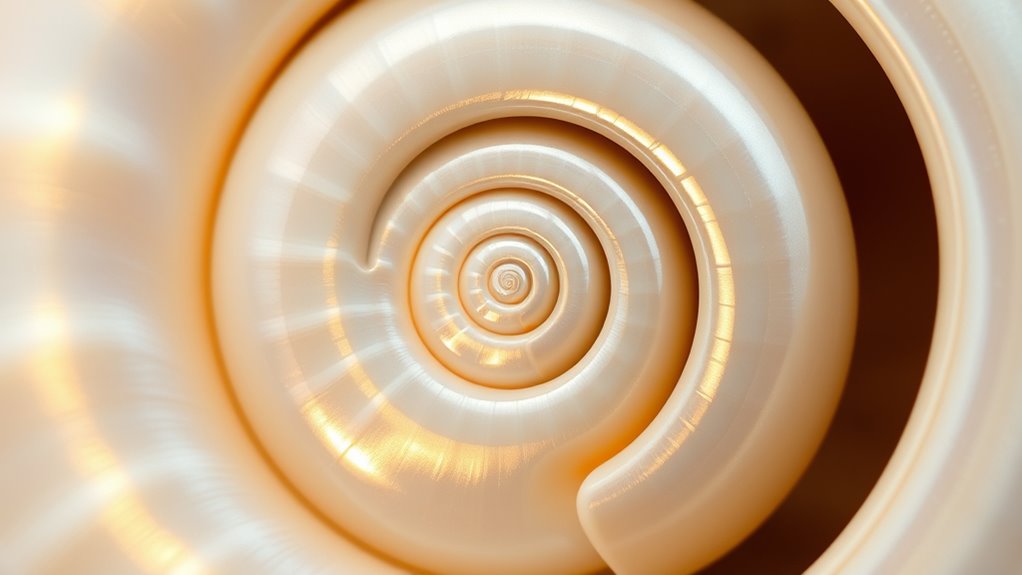
The golden spiral is a mesmerizing geometric pattern that appears throughout nature, and the nautilus shell is one of its most iconic examples. This pattern is rooted in specific mathematical proportions that create its distinct, elegant curve. When you observe a nautilus shell, you’ll notice how its whorled chambers follow a precise mathematical sequence, giving the shell its harmonious and balanced form. The golden spiral’s defining feature is its growth pattern, which maintains a consistent shape as it expands outward, making it a perfect example of how natural patterns embody mathematical proportions. These proportions can be observed in many natural structures, illustrating the universality of the golden ratio in nature. The golden spiral is based on the golden ratio, approximately 1.618, a number renowned for its aesthetic appeal and prevalence in natural and human-made structures. When you examine a nautilus shell, you see how each chamber increases in size according to this ratio, ensuring that the shell’s shape remains proportionate as it grows. This proportional relationship isn’t accidental; it’s embedded in the shell’s design, reflecting nature’s tendency to optimize for strength, growth, and efficiency. The shell’s spiral isn’t just beautiful; it’s a practical manifestation of natural patterns that follow specific mathematical rules.
As you study the nautilus shell, you’ll likely notice how its pattern exemplifies the seamless integration of form and function. The shell’s structure allows the creature inside to grow without changing its overall shape, which is achieved through the consistent application of the golden ratio in its construction. This natural pattern isn’t unique to the nautilus; many other plants, animals, and even galaxies display similar spirals governed by the same mathematical principles. Recognizing these patterns helps you understand how nature often employs efficient, scalable designs rooted in mathematical proportions.
Moreover, the golden spiral isn’t just a static pattern; it’s a dynamic blueprint for growth. The way the nautilus shell expands demonstrates how natural systems develop fractal-like structures, maintaining their proportions at every scale. When you see the shell, you’re witnessing a perfect harmony where mathematics guides the organic development of a complex, visually stunning form. This intersection of mathematics and nature reveals how fundamental patterns shape the world around us, providing insight into both biological evolution and aesthetic beauty.
In essence, understanding the golden spiral and the nautilus shell reveals how natural patterns are governed by precise mathematical proportions. It shows you that beauty in nature often arises from simple, universal principles, which are expressed through elegant, repeating geometric forms. Recognizing this connection deepens your appreciation for the intricate harmony underlying the natural world.
Frequently Asked Questions
How Is the Golden Spiral Related to the Fibonacci Sequence?
The golden spiral is mathematically linked to the Fibonacci sequence through a mathematical correlation. As you observe the sequence pattern, each Fibonacci number is used to create squares, and when quarter circles are drawn inside these squares, they form the golden spiral. This connection reveals how the sequence pattern naturally results in the elegant, logarithmic spiral seen in nature, like in shells and galaxies.
Can the Nautilus Shell’s Growth Pattern Be Applied to Architecture?
You can definitely apply the nautilus shell’s growth pattern to architecture, enhancing design and structural efficiency. Did you know that the golden ratio, found in the shell, is used to create visually appealing spaces? By mimicking this pattern, architects can develop structures that are both beautiful and resilient. Embracing the nautilus shell’s natural growth can lead to innovative architectural designs that optimize stability and aesthetics simultaneously.
Are All Nautilus Shells Perfect Golden Spirals?
Not all nautilus shells are perfect golden spirals; shell symmetry can vary, and growth irregularities often occur. You’ll notice that some shells deviate slightly from a perfect spiral due to natural factors. These imperfections add uniqueness and beauty, showing that nature’s designs aren’t always mathematically precise. So, while many shells closely follow the golden spiral, variations are common, making each shell unique in its growth and form.
What Other Natural Forms Exhibit the Golden Spiral?
Think of the universe’s secret code, like in the Fibonacci sequence. You’ll find the golden spiral in sunflower seed arrangements and pinecones, where fractal patterns create natural beauty. Botanical arrangements often display this form, guiding growth and symmetry. Even galaxies and hurricanes follow similar spirals. You notice how nature’s design echoes mathematical harmony, revealing a universal pattern that’s both mesmerizing and deeply connected to the golden spiral.
How Does the Golden Ratio Influence Human Perception?
You perceive the golden ratio through visual harmony and aesthetic appeal, which makes designs more pleasing and balanced. When you see proportions based on this ratio, your brain naturally finds them attractive and harmonious. It influences your perception by creating a sense of order and beauty, whether in architecture, art, or nature. This subconscious recognition guides your preferences, making objects or compositions that follow the golden ratio feel more compelling and visually satisfying.
Conclusion
As you marvel at the nautilus shell, it’s almost like nature’s secret code unfolds just for you. The golden spiral’s perfection mirrors life’s endless patterns, reminding you how beauty and mathematics intertwine unexpectedly. Coincidences like this make you realize that the universe’s design isn’t just random—it’s a harmonious dance you’re lucky enough to witness. So, next time you see a nautilus, remember, you’re glimpsing a timeless spiral that connects us all.

